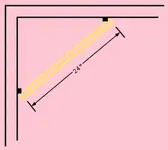Tukkis
New member
I read one of Johns post's that said that a typical gyprock wall attached to a stud frame acts as a bass trap. Is this correct??
What frequencies would this cover??
Would the thickness of the gyprock determine the frequencies??
My thickness is 16mm (.62992"). What frequencies would this thickness cover?
If this is true should I make some of Johns low/mid absorbers and place them around the room?
Wouldn't bass still build up in the corners??
I know these are alot of questions but I need someone to clarify this before I start to build.
Thanks heaps
Tukkis
What frequencies would this cover??
Would the thickness of the gyprock determine the frequencies??
My thickness is 16mm (.62992"). What frequencies would this thickness cover?
If this is true should I make some of Johns low/mid absorbers and place them around the room?
Wouldn't bass still build up in the corners??
I know these are alot of questions but I need someone to clarify this before I start to build.
Thanks heaps
Tukkis

Last edited:


